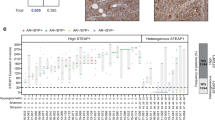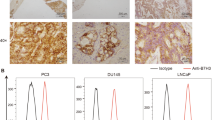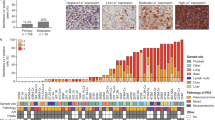Abstract
IL-13Rα2 chain, the primary interleukin-13 (IL-13) binding protein, plays an important role in IL-13 binding and internalization. Based on these findings, in our previous study we transiently transfected four cancer cell lines that do not express IL-13Rα2 chain and demonstrated that these cells acquired increased sensitivity to IL-13 receptor–targeted recombinant cytotoxin, IL13-PE38QQR, which is composed of IL-13 and a mutated form of a Pseudomonas exotoxin. Although some prostate cancer cell lines express functional IL-13R, they are not highly sensitive to IL-13 cytotoxin. Here we investigated whether human prostate cancer and normal prostate epithelial cell lines express IL-13Rα2 chain and whether they can be sensitized to the cytotoxic effect of IL-13 cytotoxin after transient or stable gene transfer of IL-13Rα2 chain. Gene transfer of IL-13Rα2 chain improved binding activity of IL-13 and sensitivity to IL-13 cytotoxin in vitro. In vivo experiments demonstrated that gene transfer of IL-13Rα2 chain dramatically enhanced the antitumor activity of IL-13 cytotoxin in human prostate cancer xenograft models. These results suggest that IL-13R–targeted cytotoxin therapy of prostate cancer may be dramatically enhanced by gene transfer of IL-13Rα2 chain and this strategy, the combination of gene therapy and cytotoxin therapy, may be utilized in the treatment of localized prostate cancer. Cancer Gene Therapy (2001) 8, 861–868
This is a preview of subscription content, access via your institution
Access options
Subscribe to this journal
Receive 12 print issues and online access
$259.00 per year
only $21.58 per issue
Buy this article
- Purchase on Springer Link
- Instant access to full article PDF
Prices may be subject to local taxes which are calculated during checkout
Similar content being viewed by others
References
Reynolds T . Prostate cancer: Numbers may not tell the whole story J Natl Cancer Inst 2000 92: 1873–1876
Davol PA, Frackelton AR Jr . Targeting human prostatic carcinoma through basic fibroblast growth factor receptors in an animal model: characterizing and circumventing mechanisms of tumor resistance Prostate 1999 40: 178–191
Vitetta ES, Fulton RJ, May RD, Till M, Uhr JM . Redesigning nature's poisons to create antitumor reagents Science 1988 238: 1098–1101
Pastan I, Fitzgerald D . Recombinant toxins for cancer treatment Science 1991 254: 1173–1177
Uckun FM . Immunotoxins for the treatment of leukemia Br J Haematol 1993 85: 435–438
Murphy JR, Vanderspek JC . Targeting diphtheria toxin to growth factor receptors Cancer Biol 1995 6: 259–267
Youle RJ . Immunotoxins for central nervous system malignancy Cancer Biol 1996 7: 65–70
Puri RK . Development of a recombinant interleukin-4– Pseudomonas exotoxin for therapy of glioblastoma Toxicol Pathol 1999 27: 53–57
Obiri NI, Debinski W, Leonard WJ, Puri RK . Receptor for interleukin 13: interaction with interleukin 4 by a mechanism that does not involve the common γ chain shared by receptors for interleukins 2, 4, 7, 9, and 15 J Biol Chem 1995 270: 8797–8804
Debinski W, Obiri NI, Pastan I, Puri RK . A novel chimeric protein composed of interleukin 13 and Pseudomonas exotoxin is highly cytotoxic to human carcinoma cells expressing receptors for interleukin 13 and interleukin 4 J Biol Chem 1995 270: 16775–16780
Puri RK, Leland P, Obiri NI, et al . Targeting of interleukin-13 receptor on human renal cell carcinoma cells by a recombinant chimeric protein composed of interleukin-13 and a truncated form of Pseudomonas exotoxin A (PE38QQR) Blood 1996 87: 4333–4339
Husain SR, Obiri NI, Gill P, et al . Receptor for interleukin-13 on AIDS-associated Kaposi's sarcoma cells served as a new target for a potent Pseudomonas exotoxin–based chimeric toxin protein Clin Cancer Res 1997 3: 151–156
Husain SR, Puri RK . Interleukin-13 fusion cytotoxin as a potent targeted agent for AIDS–Kaposi's sarcoma xenograft Blood 2000 95: 3506–3513
Joshi BH, Plautz GE, Puri RK . IL-13 receptor α chain: a novel tumor associated transmembrane protein in primary explants of human malignant gliomas Cancer Res 2000 60: 1168–1172
Obiri NI, Leland P, Murata T, Debinski W, Puri RK . The IL-13 receptor structure differs on various cell types and may share more than one component with IL-4 receptor J Immunol 1997 158: 756–764
Obiri NI, Murata T, Debinski W, Puri RK . Modulation of interleukin (IL)-13 binding and signaling by the γc chain of the IL-2 receptor J Biol Chem 1997 272: 20251–20258
Murata T, Obiri NI, Puri RK . Human ovarian carcinoma cell lines express IL-4 and IL-13 receptors: comparison between IL-4– and IL-13–induced signal transduction Int J Cancer 1997 70: 230–240
Murata T, Husain SR, Mohri H, Puri RK . Two different IL-13 receptor chains are expressed in normal human skin fibroblasts, and IL-4 and IL-13 mediate signal transduction through a common pathway Int Immunol 1998 10: 1103–1110
Murata T, Obiri NI, Puri RK . Structure of and signal transduction through interleukin-4 and interleukin-13 receptors Int J Mol Med 1998 1: 551–557
Aman MJ, Tayebi N, Obiri NI, et al . cDNA cloning and characterization of the human interleukin 13 receptor α chain J Biol Chem 1996 271: 29265–29270
Hilton DJ, Zhang JG, Metcalf D, et al . Cloning and characterization of a binding subunit of the interleukin 13 receptor that is also a component of the interleukin 4 receptor Proc Natl Acad Sci USA 1996 93: 497–501
Miloux B, Laurent P, Bonnin O, et al . Cloning of the human IL-13Rα1 chain and reconstitution with the IL-4Rα of a functional IL-4/IL-13 receptor complex FEBS Lett 1997 401: 163–166
Caput D, Laurent P, Kaghad M, et al . Cloning and characterization of a specific interleukin (IL)-13 binding protein structurally related to the IL-5 receptor α chain J Biol Chem 1996 271: 16921–16926
Kawakami K, Taguchi J, Murata T, Puri RK . The interleukin-13 receptor α2 chain: an essential component for binding and internalization but not for IL-13 induced signal transduction through STAT6 pathway Blood 2001 97: 2673–2679
Murata T, Obiri NI, Debinski W, Puri RK . Structure of IL-13 receptor: analysis of subunit composition in cancer and immune cells Biochem Biophys Res Commun 1997 238: 90–94
Kawakami K, Joshi BH, Puri RK . Sensitization of cancer cells to interleukin 13– Pseudomonas exotoxin–induced cell death by gene transfer of interleukin 13 receptor α chain Hum Gene Ther 2000 11: 1829–1835
Maini A, Hillman G, Haas GP, et al . Interleukin-13 receptors on human prostate carcinoma cell lines represent a novel target for a chimeric protein composed of IL-13 and a mutated form of Pseudomonas exotoxin J Urol 1997 158: 948–953
Oshima Y, Joshi BH, Puri RK . Conversion of interleukin-13 into a high affinity agonist by a single amino acid substitution J Biol Chem 2000 275: 14375–14380
Bright RK, Vocke CD, Emmert-Buck MR, et al . Generation and genetic characterization of immortal human prostate epithelial cell lines derived from primary cancer specimens Cancer Res 1997 57: 995–1002
Murata T, Taguchi J, Puri RK . Interleukin-13 receptor α′ but not α chain: a functional component of interleukin-4 receptors Blood 1998 91: 3884–3891
Obiri NI, Hillman GG, Haas GP, Sud S, Puri RK . Expression of high affinity interleukin-4 receptors on human renal carcinoma cells and inhibition of tumor growth in vitro by interleukin-4 J Clin Invest 1993 91: 88–93
Munson PJ, Rodbard D . Ligand: a versatile computerized approach for characterization of ligand-binding systems Anal Biochem 1980 107: 220–239
Puri RK, Ogata M, Leland P, Feldman GM, Pastan I . Expression of high affinity IL4 receptors on murine sarcoma cells and receptor mediated cytotoxicity of tumor cells to chimeric protein between IL-4 and Pseudomonas exotoxin Cancer Res 1991 51: 3011–3017
Heyman RA, Borrelli E, Lesley J, et al . Thymidine kinase obliteration: creation of transgenic mice with controlled immune deficiency Proc Natl Acad Sci USA 1989 86: 2698–2702
Mullen CA, Kilstrup M, Blaese RM . Transfer of the bacterial gene for cytosine deaminase to mammalian cells confers lethal sensitivity to 5-fluorocytosine: a negative selection system Proc Natl Acad Sci USA 1992 89: 33–37
Ram Z, Culver KW, Oshiro EM, et al . Therapy of malignant brain tumors by intratumoral implantation of retroviral vector-producing cells Nat Med 1997 3: 1354–1361
Acknowledgements
We thank Dr. Mariko Kawakami for helpful suggestions, Dr. Bharat H. Joshi for providing IL-13 toxin, and Pamela Dover for technical assistance, procurement of reagents, and reading this manuscript. These studies were performed as a part of a collaboration between FDA and NeoPharm Inc. under a Cooperative Research and Development Agreement (CRADA).
Author information
Authors and Affiliations
Corresponding author
Rights and permissions
About this article
Cite this article
Kawakami, K., Husain, S., Bright, R. et al. Gene transfer of interleukin 13 receptor α2 chain dramatically enhances the antitumor effect of IL-13 receptor–targeted cytotoxin in human prostate cancer xenografts. Cancer Gene Ther 8, 861–868 (2001). https://doi.org/10.1038/sj.cgt.7700373
Received:
Published:
Issue Date:
DOI: https://doi.org/10.1038/sj.cgt.7700373
Keywords
This article is cited by
-
Lack of association between interleukin-13 gene polymorphisms (−1055 C/T and +2044 G/A) in Iranian patients with lung cancer
Molecular Biology Reports (2009)
-
Expression of IL-13Ra2 gene in human brain tumors
Chinese Journal of Cancer Research (2005)
-
Potent antitumor activity of IL-13 cytotoxin in human pancreatic tumors engineered to express IL-13 receptor α2 chain in vivo
Gene Therapy (2003)
-
Improved Anti-tumor Activity and Safety of Interleukin-13 Receptor Targeted Cytotoxin by Systemic Continuous Administration in Head and Neck Cancer Xenograft Model
Molecular Medicine (2002)



